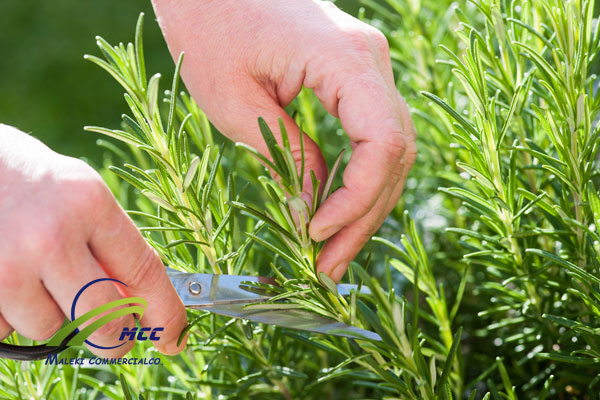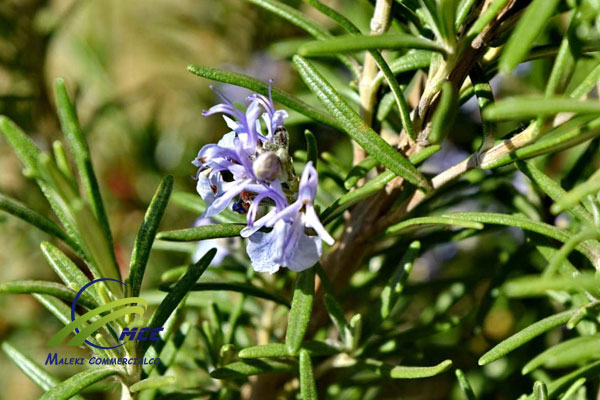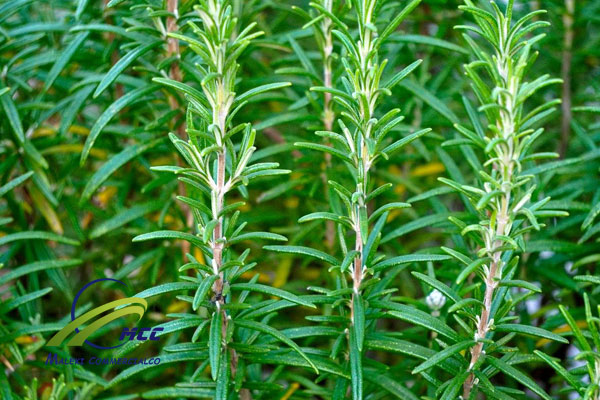All about growing rosemary
What is rosemary?
Rosemary (Rosmarinus officinalis L) belongs to the Lamiaceae family. Throughout the Middle East and Europe, this plant is widely used, and a large amount of its product is exported to other countries every year. Also, this aromatic plant is cultivating in a large area.
Botanical characteristics
Rosemary is a shrub that grows 1 to 2 meters high. The leaves of this plant are linear and 1.5 to 2.5 cm long with brown edges. The top of the leaves is dark green and the underside is covered with thick white hairs. Its four-adhered achene type fruit is firm, round and brown. Inside the fruit are small ovaries. The flowers are in clusters and are violet-blue, rarely white with 1 cm long.
Chemical compounds
- The most important constituent of this plant is the essential oil (1-2.5%), which is composed of cineole, camphor, alpha pinene, borneol, limonene and camphene. Notably, the composition of the essential oil varies according to the growing area climate.
- Other chemical compounds include phenolic acids, such as rasmarinic acid, caffeic acid, and clorogenic acid.
- There are numerous studies that confirm that rosemary has anti-cancer properties. It also has anti-AIDS capacity due to its Carnosic acid.
- In addition, this plant contains other ingredients, including a high content of salicylate, flavonoids, bitter di-terpene compounds such as carnozole and tri-terpene compounds.
Pharmaceutical part
Leaves
Geographical distribution
Global spreading
- It is cultivated in most parts of the world.
- Rosemary is grown in Iran, southern Europe, Spain, France, Italy, Yugoslavia, Asia Minor and North Africa (Morocco and Tunisia).
Distribution in Iran
- This plant is grown in the provinces of Fars, Isfahan, Tehran, Khuzestan, Bushehr, etc.
Ecology of cultivation
- This plant is native to the Mediterranean region.
- Rosemary is highly tolerant toward salinity and drought.
- This plant can be grown in most areas as it is heat and cold tolerant.
- The proper pH for this plant is between 5.6 and 7, and sandy loam soil is the best for its growth.
- In areas with full sun, a mild summer, and a frost-free winter, this plant can grow well.
Cultivation Method
- This plant is cultivated by cuttings.
- The cuttings are taken from perennial plants.
- The cuttings can be taken in late autumn.
- About one third of the cuttings are put into the soil, while the rest, which have leaves, begin to take root after 3 or 4 weeks.
- When the roots are fully formed after about three months, they are planted in nylon pots.
- In the spring, these rooted cuttings are planted out in the field.
- Approximately 14,000 rosemary cuttings must be cultivated in 1 hectare.
Fertilization
- Fertilization is done in the fall.
- To improve soil quality, 10 to 15 tons of animal manure per hectare are needed.
- For rosemary, nitrogen fertilizer is applied 2 to 3 times during the growing season to provide the necessary nutrients.
Harvest
- The plant is harvested after the second year of planting.
- Rosemary blooms between April and June.
- As long as the plant is woody, leafy and flowering branches are harvested.
- Branches with flowers, and leaves that are 30 to 35 cm in length are harvested.
Maintenance method
- The leaves should be maintained in a cool, dry place, away from sunlight and moisture.
Medicinal properties
- Carminative
- Period triggering
- Chlorotic
- Pain killer
- Antifungal
- Anti-gout
- Anti-cough
- Anti-diarrhea
- Anti-flatulence
- Anti-inflammatory
- Anti-Alzheimer’s
- Antispasmodic
- Insect repellent
- Anti-Virus Virus
- Anticonvulsants
- Anti-cancer
- Anti-ferment of the intestine
- Disinfectants for the lungs
- Rheumatic painkillers
- Nerve painkillers
- Blood pressure reducers
- Stomach booster
- Protects the liver
- Treatment of bronchitis
- Treatment of migraine
- Treatment of hysteria
- Treatment of epilepsy
- Treatment of vertigo
- Treatment of fatigue
- Treatment of depression
- Treatment of visual impairment
- Treatment of muscle pain
- Treatment of wounds and burns
- Treatment of gallbladder inflammation
- Treatment of asthma and whooping cough (pertussis)
- Treatment of indigestion
- Treatment of intestinal infections
- Treatment of painful menstruation
- Lowering of the cholesterol level in the blood
- Disinfectant for the respiratory tract
Contraindications
- Pregnant women
- Breastfeeding women
- Patients with blood coagulation disorders
Side effects of overdose
- Redness and blistering of the skin
- Skin rash
- Bleeding
Side effects
Skin allergy
Note: Please consult your doctor before taking rosemary to treat the disease.
Maleki Commercial, the largest exporter of Rosemary
Maleki Commercial is the largest direct exporter of Rosemary in Iran and Asia. This company
exports the best quality of this plant as per the buyer’s requirement in the form of EXW, FCA, CPT, CIP, DAT, DAP, FOB, FAC, CFR, CIF.
Our consultants can assist you with bulk purchases.
Supplier of Rosemary in Iran
According to buyer’s requirement, Maleki Commercial exports the best quality of Rosemary in the form of EXW, FCA, CPT, CIP, DAT, DAP, FOB, FAC, CFR, CIF.
Global export of Rosemary
Maleki commercial is one of the leading global exporters of Rosemary that have the most
effective ingredients and best quality and price among other companies that export this plant. This holding has been very successful in exporting this plant to different countries without
intermediaries.
You can rely on this company to provide the best quality products in safe and standardized
packaging when you need this kind of high-quality export.
Rosemary price in Iran
Maleki Commercial exports Rosemary at the best price and quality under the brand ElissoSky to the United States, Europe, and Asia and has already attracted numerous customers.


